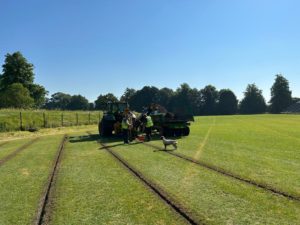SPORTS PITCH DRAINAGE
Pitches built on UK soils require primary land drainage and secondary systems are likely to be a requisite when the playing surface is to be used all year. Playing on waterlogged turf is difficult and will damage the grass. The below lists the typical sports pitch surfaces that can be impacted by rain:
- Athletic fields
- Multi Use Games Areas (MUGA)
- Football Pitches
- Rugby Pitches
- Bowling greens
- Cricket Squares
- Golf courses
- Other recreational areas
Not installing an adequate drainage system can lead to cancellation of sporting fixtures and resulting in financial losses. An efficient drainage system maintains grass sward quality, improves soil structure and keeps your playing surface at its best.
We will advise on a suitable solution for your surface, based on the soil type, your pitch requirements and the surrounding environment. We offer repairs to existing drainage systems, provide end of season installations or design and construct a comprehensive drainage solution for a new playing surface.
Our range of drainage plant and machinery and expertise in trenching, pipe installation, verti-draining and lateral drainage means we can tackle any project.
We offer the following drainage services:
PRIMARY SPORTS PITCH DRAINAGE
A typical primary drainage system consists of a network of lateral drains. These carry water to a main carrier drain and away from the pitch.
They are easy to install on an existing pitch out of season, causing little disruption to the playing schedule and minimal damage to the playing field. Once a pitch becomes waterlogged in winter it can take months before it is playable again.
We use trenchers to excavate 25 - 160 mm wide trenches. The trencher collects the spoil, lays the pipeline and tops the trench up with gravel. If required we can lay drains with specific falls, by using a laser which is attached to the trencher.

SECONDARY SPORTS PITCH DRAINAGE
Often primary drainage systems are insufficient to disperse all surface water and we recommend installing secondary surface drainage. We install this over the top of the primary drainage system. Aiding removal of the surface water, carrying it down to the primary drains and away.
Secondary drainage consists of sand slitting or banding and we carry this out using specialist machinery. The low ground pressure tyres protect the existing playing surface.
An efficient drainage system will enhance the life and quality of your playing surface - providing it is subject to a regular maintenance programme. It is far more cost effective to establish a drainage system than deal with water logging and soil compaction.
We have extensive experience in draining through existing pitches and endeavour to prevent contamination of the surface with soil or backfill gravel or sand.
SAND SLITTING / BANDING
Both sand slitting or sand banding are secondary drainage methods.
Specialist trenchers achieve sand slitting by inserting slits or trenches into the soil. These slits can be 50 - 75 mm wide and 200 to 300 mm deep. Afterward, they backfill the trenches with gravel and then sand or Rootzone.
Sand banding is a similar process we carry out with a specialist disc trencher. These excavates trenches and removes the soil from the pitch. The trenches are usually 50 mm wide and up to 400 mm deep. We insert the trenches at varying widths, dependent on the type of soil and the nature and use of the pitch. We top up the trenches with gravel and then sand in most cases. Compressing the materials prevents surface settlement.
The result of this is to enable rapid dispersal of surface water into the existing drainage network with minimal cost and as little disturbance to the soil as possible. You can use the playing field almost immediately after we complete the procedure.
GRAVEL BAND DRAINAGE
A gravel band drainer performs another form of secondary drainage. The gravel band drainer cuts a channel in the turf 100 to 350 mm deep, 25 mm wide. We can fill this channel with a variety of back fill material via a hydraulic vibrating gravel box. We then roll a wheel over the surface to compress the fill and leave the turf flat. The channels link into the primary drainage system enabling efficient water disposal.
We use a Shelton Gravel Band Drainer and use it to backfill with gravel or in some cases Lytag® which is a very efficient hydro-conductor. Where conditions allow, surfaces are playable within hours after installing the gravel bands.
MOLE PLOUGHING
The mole plough is originally an agricultural tool, which is mounted on a tractor and used for cultivating soil. In sports pitches it is used as a method of installing water pipes without trenches. This provides minimum disturbance to the playing surface. Alternatively, it can break up impenetrable soil and aid drainage.
The mole plough is a deep cutting plough with a wedge-shaped tip and a narrow shaft, which leaves a channel deep underground. We use a rear roller to leave a smooth finish. The single front coulter also minimises turf damage.




